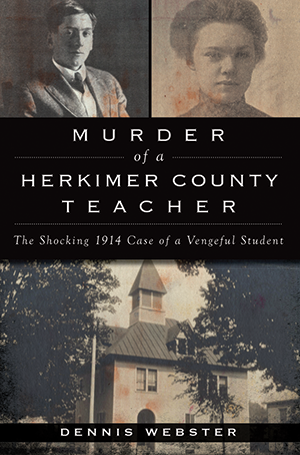
In 1914, Poland, New York, was a picturesque slice of small-town America. But that innocence was shattered with the shocking murder of beloved schoolteacher Lida Beecher at the hands of her former student Jean Gianini. At twenty-one years old, Lida wasn’t much older than her students. The son of a successful furniture dealer, Jean had all the advantages in life, but he had been labeled as different by all who encountered him.
“She wasn’t in her right mind.” “It wasn’t the real him.” “They didn’t know what they were doing.” Surely you’ve heard these claims before, whether from witnesses on the stand or from informants speaking to the press. In the aftermath of terrible crimes, supporters of the accused have often invoked the insanity defense—that the accused was not of sound mind, that the criminally insane cannot and should not be held to the same standards as the rest of us.
But have you ever learned where this defense came from? Like the famous “Texas defense” for murder—that the victim “had it coming”—the insanity defense has a specific origin in American history, an origin that can be traced all the way to the little village of Poland, in Herkimer County, New York, not far from the site of another crime we’ve explored before.

“Lida with friends at the Poland reservoir in 1913. Lida is third from left, wearing a huge smile. Courtesy Paula Johnson.” 
Jean’s portrait as he awaited trial. Absent are his glasses, which had been discussed in the trial as part of the diagnosis of his mental condition. Courtesy Herkimer County Historical Society.
Thanks to the intrepid sleuthing of historian Dennis Webster, the story of that defense can now be told. In his book Murder of a Herkimer County Teacher: The Shocking 1914 Case of a Vengeful Student, Webster— who waded through thousands of pages of court proceedings and archival documents in Herkimer County—takes his readers to a sleepy farming town that faced one of the worst crimes in its history on March 27, 1914: when the body of beloved young teacher Lydia (“Lida”) Beecher was found abandoned in a nearby wood.
Slain by one of her former students from the village schoolhouse, Beecher’s murder stunned not just the village but the entire county: sixteen-year-old Jean Gianini, a delinquent young man from a troubled family, had lured her to an out-of-the-way-spot in the woods, bludgeoned her over the head with a monkey wrench, then stabbed her multiple times to ensure her death. Though he had dragged her body some two hundred yards from the scene of the crime, once Gianini had been arrested and jailed, key evidence left behind such as a stray button from his jacket proved to secure his conviction. (Gianini had confessed, too, but the legitimacy of his confession had been called into dispute).
With such a grisly slaying, county prosecutors Charles Thomas and William Farrell sought to make an example of the boy, by urging a conviction for murder in the first degree and thus the death penalty. Yet Gianini’s defense immediately challenged this notion, claiming that the perpetrator was an ‘imbecile,’ suffered from ‘progressive idiocy’ and ‘feeble-mindedness,’ and had at most the intelligence of a ten-year-old. They called experts in abnormal psychology—called ‘alienists’—repeatedly to testify to Gianini’s capacities, including none other than the internationally-known Dr. Henry H. Goddard, who had brought the Binet Scale of assessment from Europe to the United States.
Are you criminally insane? Take the Binet tests yourself in Chapter 9 of Webster’s Book >>>
First, developed in France, the Binet Scale was created to help measure the mental age (not biological age) of children who had committed criminal acts, by assessing vocabulary, reasoning, connection-making, and awareness of causes and consequences. That Dr. Goddard deployed this test on Gianini broke new ground in juridical history, as it was the first time ever in the United States that the results of this test would appear in court. And not only did the judge rule the results admissible—that Gianini had only the intelligence of a child—they proved the deciding factor in the jury’s decision to spare him the electric chair, and commit him to life in prison instead.
Alienist Dr. Henry H. Goddard saw over forty thousand “feeble-minded” patients in his career .

He used the Binet Test to classify Jean Gianini as a “high-grade imbecile” with the mentality of a ten-year-old.
While the verdict was not surprising, the sentence was, and controversy immediately plagued the aftermath of the trial. Whether Gianini was in fact an ‘imbecile,’ or whether he was one of the best child actors in American history, remains open to some debate: highly conversant, and even capable of writing coherent poetry, Gianini was accused of hoodwinking the alienists, of pretending to be simpler-minded than he was. But the sentencing stood, and at the age of sixteen he entered the Matteawan State Hospital for the Criminally Insane in which system he would spend the next seventy-four years of his life.
Though as Webster notes, the insanity defense doesn’t come up as much as it once did (it enjoyed a brief flare-up of popularity not long after its first success), it still appears from time to time in criminal proceedings, even in the modern age. Next time, then, that you’re following a trial, and the defense makes such a move, just remember the troubled young man from rural New York, the teacher so beloved by her students, and the legacy they never knew they left behind.

GET THE FULL STORY
Murder of a Herkimer County Teacher: The Shocking 1914 Case of a Vengeful Student

In 1914, Poland, New York, was a picturesque slice of small-town America. But that innocence was shattered with the shocking murder of beloved schoolteacher Lida Beecher at the hands of her former student Jean Gianini. At twenty-one years old, Lida wasn’t much older than her students. The son of a successful furniture dealer, Jean had all the advantages in life, but he had been labeled as different by all who encountered him. The shocking murder brought the world’s best alienists to the packed Herkimer County Courthouse to try to prove that the teenager’s mental development precluded his guilt. Author Dennis Webster utilizes unprecedented access to court documents to reveal details of the sensational crime never before made known to the public.



